LONG BEACH, Calif. — For years, astronomers have pondered a cosmic version of the chicken-and-egg problem: Which came first, monster black holes or the galaxies in which they reside? A new study hints that the black holes formed first.
Supermassive black holes cram the equivalent of millions to billions of suns into a volume smaller than the solar systems at the centers of galaxies. The preliminary finding suggests that early in the universe, supermassive black holes had already packed on most of their mass, and that the fireworks and fierce winds associated with the holes’ rapid growth triggered the formation of the black holes’ host galaxies, says Chris Carilli of the National Radio Astronomy Observatory in Socorro, N.M. He reported his team’s study at a January 7 press briefing during the winter meeting of the American Astronomical Society.
But if supermassive black holes did grow rapidly in the early universe, they would have needed to snare mass from their surroundings at the maximum rate possible almost from the very beginning of the universe. Theorists aren’t sure if that’s a realistic model. That’s “one of the real sticking points in structure formation that could bring the whole house of cards down,” says Carilli.
Previous studies over the past decade, which examined galaxies much closer to Earth, had revealed a remarkable link between the supermassive black holes these galaxies house and the amount of gas and stars contained in the galaxies’ bulges — the regions that lie within a few thousand light-years of the galaxies’ cores. Regardless of their size, the bulges always turned out to be 700 times as massive as the giant black holes at the galaxies’ hubs.
That relationship suggested that galaxies and their central black holes have grown in tandem during relatively recent times in the cosmos. But astronomers didn’t know if the link held true for galaxies and their supermassive black holes during the early history of the universe.
To find out, Carilli and his collaborators, which include Dominik Riechers of the California Institute of Technology in Pasadena, used two networks of radio telescopes — the Very Large Array near Socorro and the Plateau de Bure Interferometer in the French Alps — to weigh the bulges of distant galaxies known to house supermassive black holes. The galaxies were observed as they appeared when the 13.7-billion-year-old universe was less than 2 billion years old.
From the motions of the molecular gas, which concentrates in the central part of the galaxies, the team calculated the total amount of mass in the bulges and compared that number to the mass of the central black holes.
The astronomers found that the relationship appears to break down in galaxies from this long-ago era. The supermassive black holes are much heavier, relative to the mass of the bulges, than in galaxies in the universe today.
“These very distant black holes are already about as massive as they will ever get — about 1 billion solar masses — so the only thing left is for the galaxy to form around them,” says Carilli. One implication, he says, is that the turbulent activity associated with accretion onto these black holes “may have a profound effect on the formation of the host galaxy very early in the universe.” But Carilli emphasizes that his team has examined only four galaxies from these early times. It’s possible, he says, that this handful of galaxies may have unusually heavy supermassive black holes.
“We really need to generalize to more galaxies that are less extreme,” he adds. Carilli says studies that include a much larger number of early galaxies should be possible with the Atacama Large Millimeter/submillimeter Array, or ALMA, a network of radio telescopes now under construction in Chile.
“The results are interesting, and an important clue to the growth and evolution of galaxies,” comments Martin Rees of the University of Cambridge in England. However, he adds, “I think it is over-interpreting the data to say that ‘black holes come first.’ Even at [early times] the bulge mass could typically be about 100 times larger than the mass of the hole.”
Rees suggests that the bulges and holes form concurrently throughout cosmic history, but that in the early universe “it may be easier for infalling gas to go all the way to the center of a galaxy, forming a black hole rather than condensing into stars on the way in.”
A key question that’s still unanswered, he adds, is whether galaxies must have a minimum mass in order to possess a central black hole. “This is relevant to the issue of how the ‘seed’ black holes form, and to the role of mergers … in building up galaxies,” says Rees.








